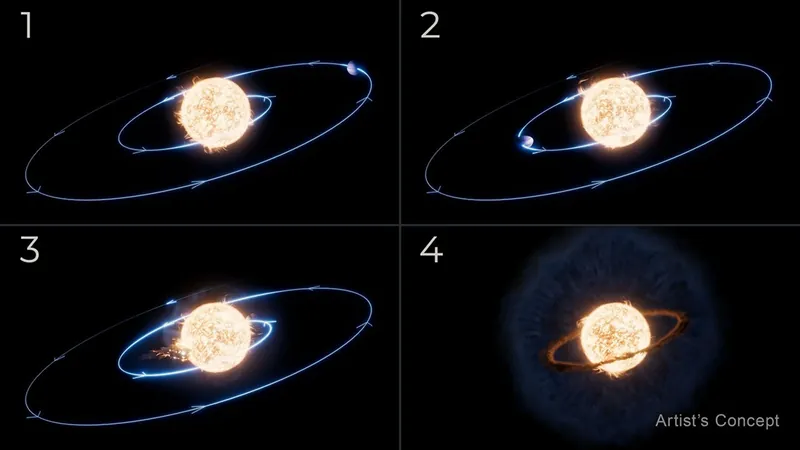
Major Discovery Changes Timeline for Oxygen-Using Bacteria: Were They Here a Billion Years Earlier?
2025-04-06
Author: Michael
New research has thrown our understanding of early microbial life into disarray, revealing that some bacteria utilized oxygen almost one billion years earlier than previously thought. This groundbreaking study, spearheaded by Dr. Adrián Arellano Davín from the Okinawa Institute of Science and Technology, draws significant connections between ancient bacteria's tolerance to oxygen and the evolutionary development of photosynthesis.
The Significance of the Great Oxidation Event (GOE)
The Great Oxidation Event, occurring around 2.4 billion years ago, marks a pivotal moment in Earth's history when oxygen began to accumulate in the atmosphere, radically transforming the planet's biosphere. Before this event, most life forms were anaerobic, thriving in oxygen-depleted environments. The implications of this new research suggest that certain bacteria were already adapting to low levels of oxygen far earlier than the GOE, surviving in niche habitats where trace amounts of oxygen existed.
As oxygen levels began to rise and permeate the atmosphere, many anaerobic organisms faced extinction, while others learned to adapt to the new conditions, setting the stage for more complex life forms to evolve in the eons that followed.
New Insights into Early Bacterial Metabolism
Historically, scientists believed that all bacterial life remained strictly anaerobic until the GOE. However, this new evidence suggests significant deviations from that paradigm. The study indicates that specific ancestral bacterial lineages might have been harnessing oxygen at least 900 million years prior to the Great Oxidation Event. The phenomenon hints at localized environments rich in trace oxygen, challenging our previous understanding of early microbial life on Earth.
The ability to metabolize oxygen offers distinct advantages; aerobic respiration is notably more efficient than anaerobic processes, allowing these early bacteria to outcompete their anaerobic counterparts.
The Role of Cutting-Edge Technology
To reconstruct the history of these early bacteria, researchers applied advanced machine learning techniques along with traditional phylogenetic analysis to assess genomic data across over a thousand modern bacterial genomes. This innovative approach enabled scientists to identify key moments when ancestral bacteria transitioned from anaerobic to aerobic lifestyles, thus paving the way for their rapid diversification during the atmospheric shift.
Interestingly, the research also emphasizes the role of cyanobacteria—known for their role in oxygenic photosynthesis—indicating that they may have already developed mechanisms to handle oxygen before they gained the photosynthetic traits that would later revolutionize Earth’s atmosphere.
Expanding Our Understanding of Early Life
Researchers have traced certain bacterial family histories back to the Hadean and early Archaean eras, a staggering 4.4 to 3.9 billion years ago. This work indicates that aerobic bacteria emerged well before the GOE, thriving and expanding in oxygen-rich environments as the atmosphere transformed.
The collaboration of geological and genomic analyses allows scientists to establish timelines for these early aerobic groups, highlighting the existence of oxygen-utilizing bacteria in localized habitats where oxygen was sporadically available.
Looking Ahead: Questions and Future Research Directions
Despite this exciting progress, many questions remain. What were the conditions that allowed for the formation of these localized oxygen pockets before the GOE? Which other organisms, if any, were able to adapt to oxygen during this period? Future research may delve into additional traits, such as antibiotic resistance or carbon fixation, exploring how these characteristics co-evolved with environmental changes.
Understanding these ancient microbial lineages may provide crucial insights into the emergence of complex life forms, including eukaryotes, ultimately reshaping our perception of the biosphere we inhabit today. The new revelations underscore the potential of early oxygen tolerance in microbes to significantly influence the evolutionary narrative of life on Earth.
Stay tuned for more updates as scientists continue to unravel the mysteries of our planet's early biosphere!









 Brasil (PT)
Brasil (PT)
 Canada (EN)
Canada (EN)
 Chile (ES)
Chile (ES)
 Česko (CS)
Česko (CS)
 대한민국 (KO)
대한민국 (KO)
 España (ES)
España (ES)
 France (FR)
France (FR)
 Hong Kong (EN)
Hong Kong (EN)
 Italia (IT)
Italia (IT)
 日本 (JA)
日本 (JA)
 Magyarország (HU)
Magyarország (HU)
 Norge (NO)
Norge (NO)
 Polska (PL)
Polska (PL)
 Schweiz (DE)
Schweiz (DE)
 Singapore (EN)
Singapore (EN)
 Sverige (SV)
Sverige (SV)
 Suomi (FI)
Suomi (FI)
 Türkiye (TR)
Türkiye (TR)
 الإمارات العربية المتحدة (AR)
الإمارات العربية المتحدة (AR)